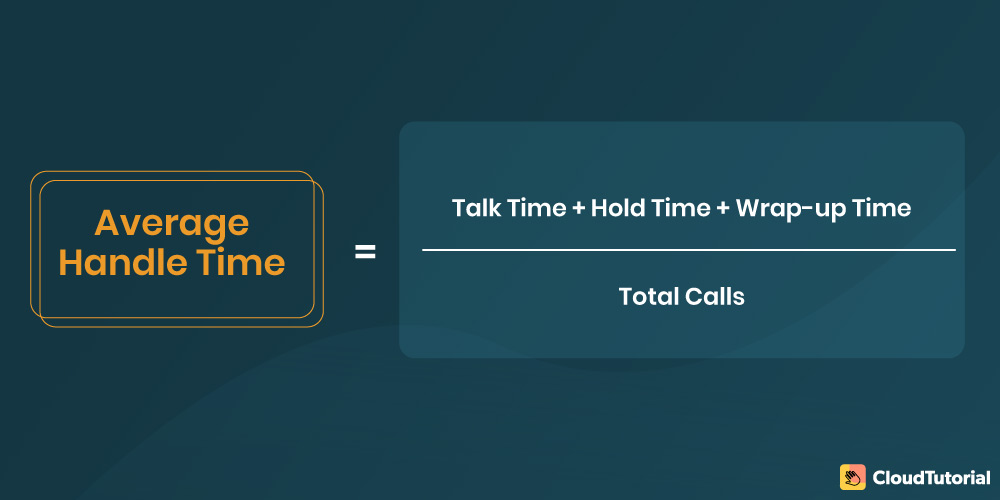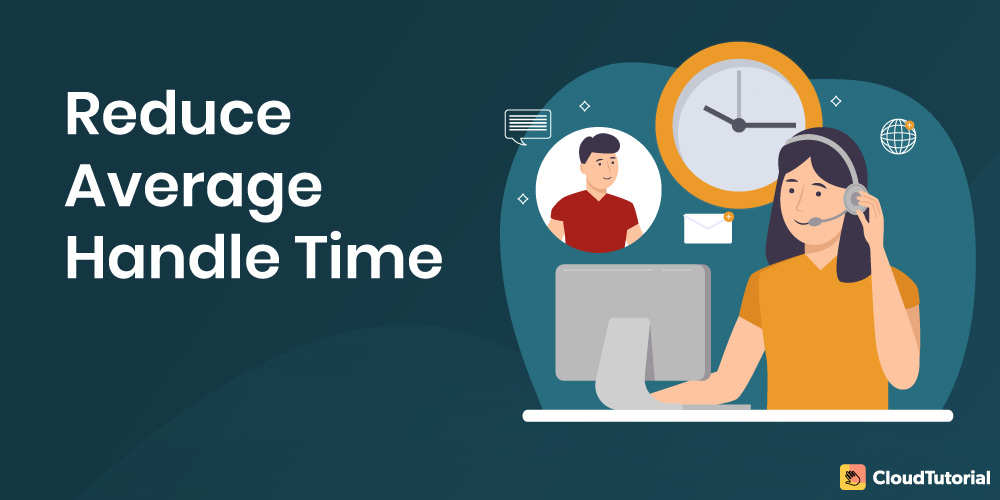What should a customer service team focus on when taking customer calls?
Should the focus be on providing a quick response? Or on giving a clear and concise answer?
Well, a customer expects both. They don’t like waiting or getting put on hold. Having to explain the problems repeatedly to the agents also feels irritating to them. Hence, the customer service reps should focus on providing the right answers and that too quickly. Having a metric to monitor the customer calls can be beneficial in fulfilling these expectations of customers.
That’s where AHT (average handle time) steps in. This metric shows how much time it takes for the customer service team to solve support requests.
In this blog, we will talk about average handle time in detail.
Table of Content
What is Average Handle Time?
It’s a customer service metric that measures the average duration it takes for the team to solve customer issues. AHT shows the amount of time that the team is spending on holds, delays, or taking further actions during customer interactions.
The call centers use it for determining the average length of the phone calls. Average handle time can also get used in analyzing business emails and chats.
Why is Average Handle Time Important?

- AHT is an essential metric because it values customers’ time. Forrester reports that 66% of people believe that the most valuable thing a business can do is appreciate the time.
- AHT can monitor the performance of your customer service reps. It will help a company make necessary changes to deliver a better customer experience.
- A reduced AHT is a good sign. It means that your customers are getting their problems solved at a quicker rate. Reduced AHT improves customer experiences and also allows your team to take more calls daily.
Average handle time is an important metric, but how to calculate it? Let’s find that out in the next section.
Build an advanced knowledge base for your customers and give them answers fast – real fast.
Take your app and help center to the next level with CloudTutorial.
How to Calculate Average Handle Time?
Here is the formula to calculate the average handle time:

[Talk + Hold + Follow up]/calls = AHT(calculated in minutes or seconds)
The math remains the same, but the variables may change depending on what communication mediums companies are using. They may be using the phone call, business email, or chat for support options. Here is how we can calculate the AHT for each of these mediums.
- Phone calls: Here is the scenario, the call center agents field 200 calls in the entire week. After adding up the values for each phone call together, the amount of talk time was 1,000 minutes. Hold time- 500 minutes. Follow-up time- 500 minutes. Here is how we can calculate the aht, [1000 talk minutes + 500 hold minutes + 500 follow-up minutes]/200 calls. The result would be 10 minutes per call.
- Business email: Emails don’t have hold times. It only has follow-ups. Here, we will calculate AHT by the total amount of time taken to solve each issue, from the time it first got opened. Here is a scenario, a company receives 500 emails. It took 10k minutes to resolve all of them. (10,000 minutes/500 emails) The aht here will be 20 minutes per email.
- Chats: The formula here will be similar to email. They don’t use hold time, only talk and follow-up time. Here is the scenario, a company takes 300 chats and spends 2,000 minutes talking to customers and 2,000 minutes taking further actions with them. [2,000 talks minutes+ 2,000 follow-up minutes]/300 chats. The aht for chat channels will be 13 minutes per chat.
As per call center magazine, the industry-standard AHT is 6 minutes and 10 seconds.
There are many tools for calculating AHT. The Erlang Calculator for call centers can quickly calculate with additional variables on the browser window. It is perfect for small contact centers and to make one-off calculations. If you want big data, then go for software.
Choose the one that can pull the data and develop simple visual charts and dashboards. Such dashboards will come in handy in sharing the data across the company. Call centers keep incorporating newer channels.
Hence, instead of calculating aht from each channel and adjusting variables each time, why not let the analytics software do all the work.
Average Handle Time: What’s Acceptable and What’s Not?
AHT depends on the approach taken by the companies to achieve customer satisfaction. It also depends on the services/products they offer and the structure of their support teams. AHT is a metric that aims for:
- Improved talk times
- Improving customer interaction
- Boosting the number of calls handled
- Reducing the hold times
These are the goals that companies should try to achieve.
Although, a lower AHT doesn’t mean the business has better performance. Agents shouldn’t hurry in solving customers’ inquiries to decrease the aht. It shouldn’t also be too high. The average handle time should be optimal enough to deliver customer satisfaction.
Build an advanced knowledge base for your customers and give them answers fast – real fast.
Take your app and help center to the next level with CloudTutorial.
How to Reduce Average Handle Time?
Here are some methods that you can apply to reduce the overall AHT.
-
Ensure that Your Agents are Effectively Trained
An untrained agent can cause a higher average handle time. Lack of agent training can cause them to fumble in the calls. They may even abruptly change the direction of the conversation during customer calls. It will waste their customers’ time and also lead to a higher aht. For an effective call center, the agents should deliver a helpful conversation without any distractions.
-
Use Self-Service Resources, like Knowledge Bases
Self-service content not only helps the customers but is also beneficial for the call center agents. Every call center should invest in a knowledge base, as these articles will act as a good reference point for solving a specific issue.
Knowledge bases will also contribute towards agent training by making them aware of the common issues that a customer experiences and how to solve them.
CloudTutorial is one such knowledge management software that can help a call center deliver excellent customer support. It will let your agents quickly search for the answers they need. You can develop an FAQ site and use it to provide solutions to your customers. With TCT, a call center provides a better customer experience.
TCT lets you separate data by category and sub-category. You can create self-service knowledge bases consisting of FAQs, procedure documents, and help articles for your agents. It will allow an agent to search and provide quick answers to their customers, ultimately delivering customer satisfaction.
Access all the information with an easy-to-use content editor. TCT comes with both a free and paid version.
-
Monitor Agent Performance
There are other essential metrics that a call center can use:
- Call resolution
- Repeat calls
- Call transfers
- Average talk time
- Calls missed
- Calls declined
- Average wait time
- Longest wait time
- Abandoned in queue
- Exceeded queue wait
- Average time to answer
- Average hold time
All these metrics can help you improve aht for your call center.
-
Call Recordings for Training Program
Call centers should record their agents’ calls and review them during agent coaching sessions. Recording calls are excellent business tools that agents can use for providing a better customer experience. They will get an in-depth knowledge of how a customer reacts during a long hold time and how they are engaging during a call.
It will give an agent a better understanding of their customers, ultimately delivering customer satisfaction. This practice will also reduce aht in the long term.
-
Optimize Call Routing and Internal Communications
A call center should figure out its routing processes, as it contributes positively to AHT and provides a better customer experience. A call should get routed to the right agent if possible because routing it to the wrong one can waste essential customer time. Customers should be able to choose which agent they want to communicate with within a call center.
There should be a mutual understanding among agents for communication and collaboration with each other. They shouldn’t rely on a third-party app for internal communications.
FAQs
Conclusion
Customers expect efficiency when they contact an agent for help. The average handle time is an essential metric that ensures the customer receives the support they expect. Also, it improves the efficiency of the entire process.
CloudTutorial helps you improve your average handle time through our knowledge base. It will provide your employees with self-service choices. Our portal will save your company’s resources by improving the response time, and all this will reduce the burden on your customer service reps.
Try it out before you decide.
Create a test article NOW!
Using this tool, all you have to do is add your first test article and see how it looks. Now, you don’t have to sign-up or login into CloudTutorial software just to check how your first article appears.

